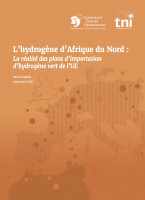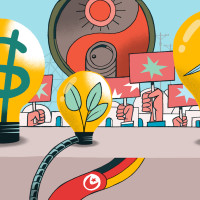Assessing EU plans to import hydrogen from North Africa The cases of Morocco, Algeria and Egypt
Regions
This report shows the EU’s plan to drastically increase imports of renewable hydrogen from North Africa is not realistic from a cost or energy perspective, and instead diverts renewable electricity away from local needs and local climate targets.

Downloads
About assessing eu plans to import hydrogen from north africa
- Publication type
- Report
Authors
Authors
Executive summary
The European Commission’s 2020 hydrogen strategy has a big focus on importing ‘green’ renewables-based hydrogen from its neighbourhood (North Africa and Ukraine). Since the recent invasion of Ukraine and the subsequent need to reduce dependency on Russian gas, the EU has doubled its import targets to 10 million tonnes per year by 2030, as per the RePowerEU communiqué.
This report examines three North African countries that in recent years are increasingly focused on hydrogen, based in significant part on the interest of the EU and its corporations. Morocco, Algeria and Egypt are all planning to manufacture green hydrogen and hydrogen-based products, and ship them to the EU via boats and pipelines, to help meet this projected demand. But how feasible are such plans, how much would they cost, and would they be the best use of renewables in those countries?
There are big question marks over whether green hydrogen can ever be exported at sufficiently attractive prices, given the high production and transportation costs:
- Using intermittent renewables to power electrolysers will lead to higher costs, but connecting to the grid to mitigate against this could further increase costs, as well as the CO2e footprint. It would also undermine the EU’s criteria for green hydrogen.
- Shipping green hydrogen by sea takes three times the energy to liquify it as natural gas requires, while the same volume of tanker would only carry 27% of the energy. Also, 0.2% of the hydrogen would boil off every day while being shipped.
- Transporting hydrogen via pipeline damages the pipes themselves, and the electronic equipment within them. The density of hydrogen would require tripling the energy used, and thus also the cost of pumping it through the pipelines. There will also be high fugitive emissions.
Green hydrogen could cost as much as 11 times more than natural gas per unit of energy at prices before the winter energy crisis and the invasion of Ukraine, even before storage and transportation. Hydrogen is expensive to distribute via shipping and pipeline, which is why today the large majority of it is manufactured at the point of consumption. Realistically, is Europe going to be willing to pay that very significant price difference?
North African governments and firms should therefore be wary of promises of large export markets for expensive to manufacture and ship green hydrogen, and the synthetic fuels made from it.
In oil and gas producing Algeria and Egypt, the hydrogen projects being explored are not just based on renewable electricity (‘green’), but also on gas with carbon capture and storage (‘blue’). Blue hydrogen is still double the price of unabated (‘grey’) hydrogen, and has the significant problem of high CO2e emissions, especially if the captured CO2 is used for enhanced oil recovery.
As all three countries examined have significant fertiliser industries, and either produce or import large quantities of grey ammonia, greening this domestic use could have a short-term climate impact before transitioning to agricultural practices that are not so fertiliser intensive.
The renewable electricity generated by these countries could also be better used to displace domestic fossil fuel power generation and meet local energy needs, while interconnectors with neighbouring countries - and eventually the EU - could help balance grids.
It makes little sense for Morocco, Algeria or Egypt to use their renewable electricity to make hydrogen and products from hydrogen, then ship them to Europe at significant loss of energy, so that the EU can achieve climate emissions reductions. And would European consumers be prepared to foot the very significant bill? The EU may need to re-examine its hydrogen strategy, in particular its green import targets, and reassess the feasibility and cost of achieving them.
Morocco
- Morocco aims to replace ammonia imports with local green production for its national fertiliser industry
- Beyond eliminating high ammonia emissions, other touted uses of green hydrogen don’t hold up to scrutiny
Algeria
- Algeria plans to gradually switch its EU exports from natural gas to green and blue hydrogen, with interest from European partners
- Eni’s green hydrogen solar project is predicted to cost 11 times more per unit of energy than natural gas, even before distribution
- Eni is also looking at blue hydrogen, which will cost more than double grey (unabated), and will be five times the cost of natural gas per unit of energy, with significant methane emissions
Egypt
- Green hydrogen is seen as a key economic development pathway. The EBRD is helping, while Egypt is already providing fiscal support measures.
- Maersk involved in a project developing hydrogen-based shipping fuels to replace polluting bunker fuel but they face challenges:
- Green methanol is toxic, has half the energy density of bunker fuel and could cost around five times as much;
- Green ammonia also toxic, with spills on a ship potentially life threatening, and will cost almost four times as much as marine fuel.
- Numerous European companies involved in green and blue hydrogen export projects around Suez Canal Economic Zone.
Related
L’hydrogène d’Afrique du Nord La réalité des plans d’importation d’hydrogène vert de l’UE
- Middle East and North Africa
- Green Economy
- Just Transition

Credits
Authors
In collaboration with
Downloads
Publication: Newsletter banner
Did you enjoy reading this content?
Sign up for the newsletter to receive monthly updates on TNI’s research, events, and publications.
Newsletter Subscribe to our newsletter
More like this
-
An unjust transition Energy, colonialism and extractivism in occupied Western Sahara
- Just Transition
- Climate Crisis
- Middle East and North Africa
Longread byPublication date:- Joanna Allan
- Hamza Lakhal
- Mahmoud Lemaadel

-
The Moroccan energy sector A permanent dependence
- Just Transition
- Energy Democracy
- Middle East and North Africa
Longread byPublication date:Jawad Moustakbal
-
‘Renewable’ energy in Tunisia An unjust transition
- Energy Democracy
- Just Transition
- Middle East and North Africa
Longread byPublication date:- Chafik Ben Rouine
- Flavie Roche

-
What can an old mine tell us about a just energy transition?
- Just Transition
- Energy Democracy
- Middle East and North Africa
Longread byPublication date:Karen Rignall
-
Towards a just agricultural transition in North Africa
- Just Transition
- Climate Crisis
- Middle East and North Africa
Longread byPublication date:Saker El Nour